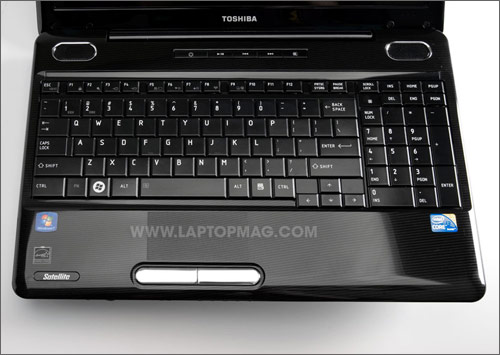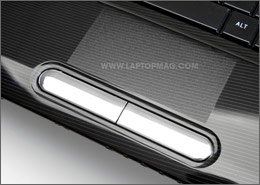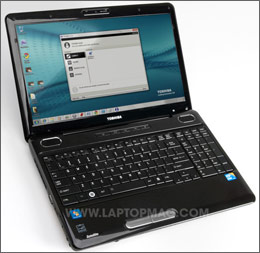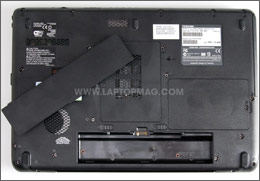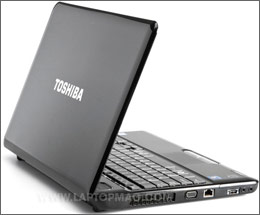Laptop Mag Verdict
Improved performance and battery life makes this budget notebook an even better deal than before.
Pros
- +
Good performance
- +
Responsive touchpad and mouse buttons
- +
Good software and utility package
- +
Loud speakers
Cons
- -
Keyboard flexes
- -
Screen a bit dim
- -
No HDMI output
- -
Glossy finish attracts smudges
Why you can trust Laptop Mag
Editor's Note: Portions of this review were taken from our earlier review of the Toshiba Satellite L505-S5966.
Toshiba is looking to make a good thing even better with the next generation of its Satellite L505 budget notebook by packing one of Intel's new Core i3 processors inside. This has the benefit of upping performance without sacrificing the L505's low-cost roots. Priced at $699, this notebook is still a good choice for consumers looking for a system that can handle multimedia well, but now users can count on far better performance without breaking the bank. We wish the display were brighter and that Toshiba included an HDMI port, but overall the L505 is a heck of a bargain.
Design
For a budget system, the Satellite L505 is attractive. Its lid and keyboard deck sport Toshiba's Fusion Finish in Midnight Breeze. This propensity for glossiness attracts fingerprint smudges in a hurry, but the faint taupe lines running diagonally across the deck and lid hide these somewhat. Unlike the previous model, the keyboard is glossy instead of matte.
At 15.1 x 10.2 x 1.6 inches and an even 6.0 pounds, the Satellite L505 isn't exactly travel-friendly, but it's a reasonable size and weight for a 15.6-inch system.
Above the keyboard is the power button, plus four physical media playback buttons: Play/Pause, Reverse, Forward, and Mute. There are no volume buttons; Toshiba continues to use an old-school volume wheel, which in this case is on the front edge of the L505. The slightly more expensive Satellite A505 (which starts at $749) has touch-sensitive media and volume controls.
Heat
Sign up to receive The Snapshot, a free special dispatch from Laptop Mag, in your inbox.
The L505 stays relatively cool. After playing a Hulu video on full screen for 15 minutes, we measured the temperature between the G and H keys at 89 degrees Fahrenheit, the touchpad at 91 degrees, and the center of the bottom at 89 degrees--all below our acceptable threshold (95 degrees). There's a hot spot on the bottom left of the laptop that gets up to 99 degrees, but that temperature remains tolerable.
Keyboard and Touchpad
Click to enlarge
Click to enlargeThe black keyboard on the L505 provided very good feedback, although we did notice a bit more flex than we would have liked. Thanks to the wide 15.6-inch screen, Toshiba was also able to cram in a full number pad to the right without sacrificing the size of the keyboard.
The touchpad is nicely sized, and its mildly gritty surface resulted in almost no friction when moving our finger across it. However, it blends in almost seamlessly with the surrounding deck, making the touchpad difficult to locate without looking--at least at first. The huge silver mouse buttons below extend beyond the width of the touchpad; they provided decently crisp feedback.
Display and Audio
Click to enlarge
The 15.6-inch screen on the L505 is not the brightest we've seen. While the resolution of 1366 x 768 is adequate for this size display, we often found ourselves trying to pump up the brightness when surfing the Web, only to find that the notebook was already on the maximum setting. We also had to tilt the display back a little in order for it not to appear washed out. When set at the ideal angle, though, watching movies on the 16:9 aspect ratio display was enjoyable. During an explosion in a clip from The Hurt Locker, we could make out the individual bits of gravel and dust stirred up by the IEDs.
The stereo speakers on the top of the deck were relatively loud but, as is to be expected in this price range, they lacked a low end. We could easily hear John Legend's "Alright" from across a room, but it felt incomplete and thin without the bass line.
Ports and Webcam
Arrayed along the right side of the Satellite L505 are two USB 2.0 ports, the modem port, a Kensington lock slot, and the DVD drive; a 2-in-1 card reader sits to the right of the volume wheel on the front of the system; on the left is VGA out, Ethernet, headphone and mic, and an eSATA port that doubles as USB. Unfortunately, this port doesn't include Toshiba's Sleep-and-Charge technology. Also lacking is an HDMI port, but this isn't a deal-breaker in this price range.
Click to enlarge
Click to enlarge
A VGA webcam and microphone above the display provided surprisingly dull, muddy images in a video chat over Skype; while they appeared a little drab, a caller could make out the color of our eyes. However, there was a bit of motion blur when we waved our hand about two feet away from the webcam. The L505 features Toshiba's Face Recognition program for logging in. Unfortunately, the poor image quality gave us a hard time when we tried registering our face.
Performance
Click to enlarge
Toshiba updated the L500 series to include Intel's new Core i3-330M processor. Though it lacks the Turbo Boost technology reserved for Core i5 and Core i7 notebooks, the L505 demonstrated good performance in our tests.
In addition to the 2.13-GHz CPU, the system's 4GB of RAM and 5,400-rpm hard drive helped deliver a score of 4,918 on PCMark Vantage, over 1,000 marks above the category average of 3,631. The L505's score barely squeaked by the Gateway NV7915u (4,907), another Core i3 notebook, and was double that of the previous generation L505 (2,791). Compared to a Core 2 Duo system such as the ASUS K50, the L505 handily outperforms its score of 3,100.
You should have no problem using the L505 for everyday tasks. We surfed the Web, streamed music via Last.fm, played Flash games, and wrote this review in Microsoft Word simultaneously without any hiccups.
The L505's 5,400-rpm, 320GB hard drive did not beat its predecessor on the LAPTOP Transfer Test (duplicating 4.97GB of mixed media files). The last generation L505 completed this task at a rate of 23.6 MBps, while the current system only achieved 20.9 MBps. This speed is just a little above the category average, yet it lags behind the Gateway NV7915u (24.2 MBps) and ASUS K50 (25.2 MBps). The L505 booted into Windows 7 Home Premium in 61 seconds, just 1 second slower than average.
When we used the L505 to transcode a 114MB, 5-minute-and-5-second video using Oxelon Media Converter, it took 1 minute and 12 seconds. While this is just 5 seconds longer than the Gateway NV7915u (1:07), it's still 20 seconds slower than average.
Graphics
The Satellite L505 benefits greatly from Intel's GMA HD integrated graphics when it came to video playback, but even mild gaming prowess is still lacking. The notebook scored 1,743 in 3DMark06--more than 1,000 points better than the previous generation L505 (715) and the ASUS K50 (859), and again very close to the Gateway NV7915u (1,735). Still, the mainstream notebook average is 3,157, though this includes machines with discrete graphics.
Playback was smooth on the L505 when watching both the 720p and 1080p trailers for The Discoverers, downloaded from Microsoft's Windows WMV HD Content Showcase. Our pet moved a bit slower than normal while playing Pet Society (a Facebook Flash game), but gameplay wasn't hindered.
Not surprisingly, the L505 was barely able to play the graphically demanding Far Cry 2, notching just 11 frames per second at a resolution of 1024 x 768. It did better running World of Warcraft: 30 fps at the same resolution, which is playable (but not great). Frame rates dropped to 10 fps in W.O.W. when we upped maxed out the resolution.
Battery Life and Wi-Fi
Click to enlarge
The six-cell battery on the Satellite L505 lasted 3 hours and 7 minutes, almost an hour longer than its predecessor and closer to the mainstream category average of 3:31. The Core i3-powered Gateway NV7915u lasted just 20 minutes longer (3:27), and the Core 2 Duo model of the ASUS K50 outlasted the L505 by 43 minutes (3:50). The L505 includes Toshiba's Eco utility, accessible through the Power Options menu, which enables power-saving features such as dimming the display and turning off the hard disk after five minutes of inactivity.
This laptop exhibited strong Wi-Fi throughput of 43.9 Mbps and 27.2 Mbps at 15 and 50 feet from our router, respectively. This means you'll be able to stream media without a problem, even if you're not in close proximity to a wireless connection.
Green Testing
The L505 took 2 hours and 1 minute to fully recharge, using an average of 52.8 watts during that time. Its LAPTOP Battery Efficiency Rating of 34.2 is a good deal better than the 45.5 category average. (Lower is better for this test.) Its EPEAT rating of 22 is good, considering that score tops out at 27.
Software and Warranty
Click to enlarge
Toshiba loaded the L505 with a decent suite of useful programs beyond the Eco utility. Most are aimed at making maintenance easy, like the Recovery Media Creator, PC Diagnostic Tool, and Toshiba Assist for quick access to tools for connecting, securing, optimizing, and fixing your notebook.
Toshiba's Bulletin Board also helps users keep on top of maintenance tasks while providing a quick, easy way to create a virtual board for messages and notes. ReelTime is a handy Toshiba program that shows recently opened media in a chronological timeline so you can easily find documents, videos, and more based on the last time you accessed them.
In addition to Toshiba's utilities, the L505 includes a 60-day trial of Microsoft Office Home and Student 2007. You also get Microsoft Works, and WildTangent Orb game console. Additionally, there are shortcuts to NetZero, Amazon.com's online stores, and Intuit QuickBooks Financial Center.
Toshiba protects the L505 with a standard one-year parts-and-labor warranty with 24/7 toll-free tech support. To see how Toshiba fared in our annual Tech Support Showdown, click here.
Configurations
Click to enlarge
Toshiba offers many different configurations of the L500 series. The base model (L505D-LS5002, $459) features an AMD Sempron M100 processor, 2GB of RAM, a 5,400-rpm, 250GB hard drive, and lacks a webcam and mic. The top-of-the-line model, the L505-GS5037 ($713), also comes with a Core i3 processor and 4GB of RAM, but it includes a larger 500GB hard drive.
Verdict
The Toshiba Satellite L505-GS5035 should fit most users' needs, and at $699 it represents a good balance between power and price. For $50 less you could opt for more screen real estate with the similarly powerful 17-inch Gateway NV7915u, which also includes a better webcam and an HDMI port. If you want to stick to a 15.6-inch display, however, the L505 offers good value and a wealth of configuration options.
Toshiba Satellite L505-GS5035 Specs
| Brand | Toshiba |
| CPU | 2.13-GHz Intel Core i3-330M |
| Card Slots | 5-1 card reader |
| Company Website | http://www.toshibadirect.com |
| Display Size | 15.6 |
| Graphics Card | Intel GMA HD |
| Hard Drive Size | 320GB |
| Hard Drive Speed | 5,400rpm |
| Hard Drive Type | SATA Hard Drive |
| Native Resolution | 1280x768 |
| Operating System | MS Windows 7 Home Premium (64-bit) |
| Optical Drive | DVD /- R |
| Ports (excluding USB) | Kensington Lock, Headphone, Ethernet, eSATA/USB, VGA, Modem, Microphone |
| RAM | 4GB |
| RAM Upgradable to | 4GB |
| Size | 15.1 x 10.2 x 1.6 inches |
| USB Ports | 2 |
| Video Memory | Shared |
| Warranty/Support | One-year parts-and-labor/24/7 toll-free phone |
| Weight | 6.0 pounds |
| Wi-Fi | 802.11b/g/n |
K. T. Bradford writes about laptops, apps, and ebook readers for Laptop Mag. She has written reviews of some of the most iconic laptops from the last decade and more, covering models such as the Acer Aspire One, the Samsung R580, and the Lenovo IdeaPad S205. Some of her other reviews include MSI, HP, Dell, and Asus notebooks.
